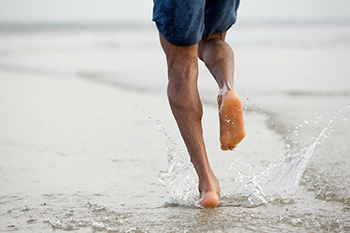 Cuboid syndrome is a partial dislocation of the bones in the middle of the foot. While cuboid syndrome is typically the result of overuse or injury, pronated feet (feet that turn inward when walking), training on uneven surfaces, poorly fitted shoes, and climbing stairs can all be contributing factors as well . A common sign of cuboid syndrome is pain on the outside of the foot near the little toe. Pain may also be felt in the middle of the foot, or at the base of the fourth and fifth toes. Since the pain is sometimes difficult to pinpoint, cuboid syndrome is often confused with a stress fracture. Other symptoms can include difficulty walking, swelling, pain that becomes worse with weight-bearing, and increased pain when lifting the heel and pushing off the toe. If you are experiencing any pain in the foot it is highly recommended to consult with a podiatrist for a proper diagnosis and treatment.
Cuboid syndrome is a partial dislocation of the bones in the middle of the foot. While cuboid syndrome is typically the result of overuse or injury, pronated feet (feet that turn inward when walking), training on uneven surfaces, poorly fitted shoes, and climbing stairs can all be contributing factors as well . A common sign of cuboid syndrome is pain on the outside of the foot near the little toe. Pain may also be felt in the middle of the foot, or at the base of the fourth and fifth toes. Since the pain is sometimes difficult to pinpoint, cuboid syndrome is often confused with a stress fracture. Other symptoms can include difficulty walking, swelling, pain that becomes worse with weight-bearing, and increased pain when lifting the heel and pushing off the toe. If you are experiencing any pain in the foot it is highly recommended to consult with a podiatrist for a proper diagnosis and treatment.
Cuboid syndrome, also known as cuboid subluxation, occurs when the joints and ligaments near the cuboid bone in the foot become torn. If you have cuboid syndrome, consult with Brent Harwood, DPM from Southeast Podiatry. Our doctor will assess your condition and provide you with quality foot treatment.
Cuboid syndrome is a common cause of lateral foot pain, which is pain on the outside of the foot. The condition may happen suddenly due to an sprain, or it may develop slowly overtime from repetitive tension through the bone and surrounding structures.
Causes
The most common causes of cuboid syndrome include:
Symptoms
A common symptom of cuboid syndrome is pain along the outside of the foot which can be felt in the and toes. This pain may create walking difficulties and may cause those with the condition to walk with a limp.
Diagnosis
Diagnosis of cuboid syndrome is often difficult, and it is often misdiagnosed. X-rays, MRIs and CT scans often fail to properly show the cuboid subluxation. Although there isn’t a specific test used to diagnose cuboid syndrome, your podiatrist will usually check if pain is felt while pressing firmly on the cuboid bone of your foot.
Treatment
Just as the range of causes varies widely, so do treatments. Some more common treatments are ice therapy, rest, exercise, taping, and orthotics.
If you have any questions, please feel free to contact one of our offices located in Fairhope, Brewton, and Atmore, AL . We offer the newest diagnostic and treatment technologies for all your foot care needs.
Read more about Cuboid Syndrome
Cuboid syndrome mostly affects athletes, although it can affect non-athletes too. It is also known as cuboid subluxation or cuboid fault syndrome. This condition occurs when joints and ligaments near the cuboid bone of the foot are damaged, or when the cuboid bone itself is dislodged from its natural position. It is usually marked by pain on the outer side of the foot, which may be persistent or may come and go. Cuboid syndrome can be difficult to diagnose unless it becomes severe and more noticeable. Your doctor will likely ask questions about when the pain began and how long it has been present, and will put pressure on the cuboid bone to determine if that area is the origin of the pain.
Causes of Cuboid Syndrome
Disagreements Amongst Podiatrists Regarding Cuboid Syndrome
It is very important that when you experience any kind of pain on the side of your foot, you should seek medical care right away. If a subluxed cuboid is caught early, your feet may respond well to the treatment, and you can get back into sports or other activities again as soon as the pain subsides.